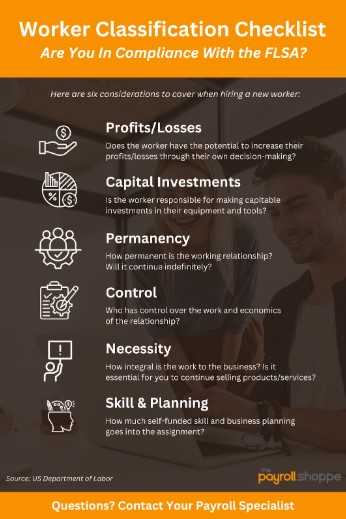
Your ‘Employee Or Independent Contractor?’ Checklist: How to Tell the Difference Between W-2 and 1099 Workers [With Downloadable Infographic]
Worker classifications are tricky, and many, many companies get it wrong. Some of the most surprising statistics when it comes to employees and independent contractors:
- 3.4 million workers are likely misclassified right now, according to the Economic Policy Institute.
- 15% of employers have misclassified at least one worker, according to a 2009 IRS study.
- 10-30% of employers misclassify their workers, according to the US DOL and GAO Reports.
With so much at risk, wouldn’t it be great to have an employee or independent contractor checklist? Well, we’ve built one for you, and you can download it to keep it near your desk for future reference:
Myths of 1099s
We often hear from companies that have unintentionally fallen out of worker classification compliance, usually either because they wanted to avoid paying taxes or because they genuinely misunderstood the law.
But those mistakes can be costly. Some of the most common misunderstandings and myths of 1099s we’ve heard include:
1. “There’s a payment threshold to whether or not someone is a W-2 or 1099, and as long as they’re underneath it, I’ll be OK.”
There is a threshold to 1099s, but it has nothing to do with classifications. If an independent contractor is paid more than $600 throughout the year, they should receive a 1099 at the end of the year.
But, again, this has nothing to do with worker classification.
2. “I can pay someone as a 1099 because they’d prefer it that way.”
We hear this all the time—a worker requests to receive a 1099 because they won’t have their wages garnished during each payroll run.
Unfortunately, this is illegal. If a worker is an employee, they should be paid as an employee—not as an independent contractor.
3. “I have someone who’s coming onto the team part-time temporarily, so they don’t need to be treated as a full employee.”
Your part-time employees might not have access to your full benefits package (like health care and retirement), but they may still qualify as employees under the Fair Labor Standards Act.
If that’s the case, they’re entitled to the same protections and tax treatments as a typical full-time employee.
Penalties for Worker Misclassification
Misclassification isn’t just illegal; it’s costly. Being caught opens you up to penalties from the Department of Labor, the Internal Revenue Service, stage agencies, and more.
Some of the most common penalties:
1. Backpay
True contractors aren’t eligible for overtime and minimum wage. But if a worker is found to qualify as an employee, you may be held retroactively responsible for minimum wage or overtime payments, if workers are found deserving of them.
2. Back taxes
Contractor payments don’t withhold for unemployment, social security, and medicare. If your company is found guilty of worker misclassification, you may owe taxes for payments you’ve already made.
3. Penalties
Legal penalties vary from case to case, but some companies pay up to 20% of wages. In extreme cases, government agencies may seek criminal charges and fines of $500,000.
4. Legal fees
Class action lawsuits are growing more and more common against employers who habitually or knowingly misclassify their workers—as we’ll explore in our next section. Even if you win a lawsuit, you’ll still be on the hook for costly legal payments.
5. Reputation
Today’s consumers are better informed than ever before, and many seek to purchase goods and services from companies doing good for the community. Misclassifying workers reflects poorly on your brand, and that could harm your reputation and sales!
Examples of Worker Misclassification Lawsuits
Worker misclassification lawsuits are more common than ever before, especially as the “gig economy” has thrust countless new, towering businesses into the spotlight, like Uber, Lyft, and DoorDash.
With that in mind, here are a few noteworthy cases from recent years:
1. Amazon Flex Drivers Challenge Classification in Wisconsin and Beyond
In 2024, the Wisconsin Supreme Court upheld a lower court ruling that Amazon Flex drivers were employees, not independent contractors, making them eligible for unemployment benefits.
This decision affected over 1,000 drivers and could cost Amazon Logistics more than $200,000 in unemployment insurance premiums. Similar rulings have emerged in other states, including Virginia, where courts have also determined that Amazon Flex drivers are employees. (Source: Associated Press)
2. FedEx Settles $240 Million Misclassification Lawsuit
In June 2016, FedEx agreed to a $240 million settlement to resolve class action lawsuits filed by delivery drivers across 20 states. The drivers alleged they were misclassified as independent contractors, which denied them wages and benefits owed to employees. (Source: Berger Montague)
3. Gopuff Fined $6.2 Million for Misclassifying Drivers
In March 2023, the Massachusetts Attorney General fined delivery startup Gopuff $6.2 million for misclassifying its drivers as independent contractors and other labor law violations. The misclassification denied drivers benefits such as minimum wage, overtime, and unemployment insurance. (Source: CNN)
4. Flowers Foods Pays $55 Million in Settlement with Distributors
In September 2023, Flowers Foods, a national baked goods company, agreed to a $55 million settlement with a class of 475 distributors. The distributors claimed they were misclassified as independent contractors, which violated California labor laws. (Source: Troutman Pepper Locke)
Employee or Contractor? 6 Questions to Ask
While the line between employees and independent contractors may seem fuzzy, the Department of Labor offers helpful guidelines based on the Fair Labor Standards Act.
The FLSA considers six different factors:
- Opportunity for profit or loss depending on managerial skill
- Investments by the worker and the employer
- Permanence of the work relationship
- Nature and degree of control
- Whether the work performed is integral to the employer’s business
- Skill and initiative
With that in mind, here are six questions to consider when weighing the legality of a contractor designation:
| Question | Employee-Leaning Response | Contractor-Leaning Respons |
|---|---|---|
| Can the worker increase profits or suffer losses through their own effort and decision making? | No, they take strategic direction from an internal manager, and they must be approved for additional hours to earn more money. | Yes, the individual can increase their earning potential through marketing and advertising, hiring their own team members, and can increase income by raising their rates or sourcing additional clients. |
| Who is responsible for making capital investments in the company? | I am. The worker is not responsible for purchasing tools and software critical to completing assignments. | The worker. They purchase their own tools and software and may determine which ones are optimal for completing tasks |
| How permanent is the working relationship? | It’s ongoing or seasonal. We work together on a very set schedule and will continue working together indefinitely. | It’s temporary or project-based. The worker may leave at any time and may bring on additional clients. |
| How much control do you have over the work and the economics of the relationship? | Full control. I am allowed to determine what tools are used, how much our company pays for products and services, and which team members are hired and fired for the project. | Limited control. The worker uses their own tools, sets their own rates, and can hire and fire their own team members at will. |
| How integral is the work to your business? | It’s essential. We need to have this position filled to continue serving our own customers and clients. | It’s not essential. Technically, we can continue operating without hiring this individual’s services. |
| How much self-funded skill and business planning goes into the assignment? | It’s limited. We pay for the worker’s training, and they have limited business control and oversight. | All of it. They are responsible for their own training and skill development, and they can pick and choose new skills to develop based on their own business initiatives. |
Remember: There’s rarely a one-size-fits all scenario. Many working relationships are unique, and answers are often complex and nuanced.
But these questions can help you understand whether a worker is leaning more toward a true employee or an independent contractor.
Find Payroll Support For Your Employees
If you’re worried about worker classification and accurate payrolls, contact us. We’ll help you accurately classify your employees through our thorough hiring and onboarding services and our complete payroll.

